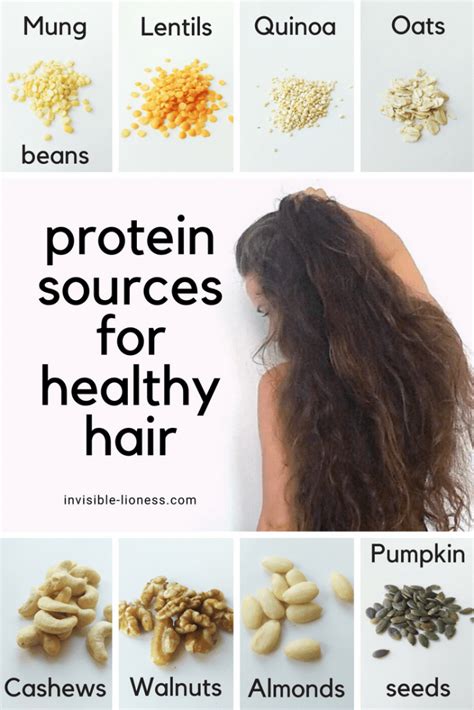Introduction: The Power of Protein
Protein is an essential macronutrient that plays a crucial role in hair growth and vitality. Composed of amino acids, proteins provide the building blocks for healthy hair follicles, hair shafts, and scalp health. Understanding the importance of protein for hair can help you achieve your hair goals and maintain a beautiful, lustrous mane.

Why Protein is Essential for Hair
- Hair Shaft Structure: Hair shafts are primarily composed of a protein called keratin. Keratin helps maintain hair’s strength, elasticity, and resistance to damage.
- Hair Growth: Protein is essential for hair growth and repair. Amino acids from proteins are used to synthesize new hair cells and maintain the integrity of existing follicles.
- Scalp Health: Protein supports a healthy scalp by providing nutrients to follicles, reducing inflammation, and regulating oil production.
Benefits of Protein for Hair
- Increased Strength and Elasticity: Protein strengthens hair shafts, reducing breakage and split ends. It also improves hair’s ability to withstand mechanical stress, such as combing and styling.
- Improved Growth and Thickness: Protein deficiency can lead to slow hair growth and thinning. Adequate protein intake supports healthy hair follicle function, resulting in thicker, fuller hair.
- Reduced Shedding and Breakage: Protein strengthens hair shafts, making them less prone to shedding and breakage. This helps maintain hair density and prevent hair loss.
Protein Sources for Hair
- Animal Proteins: Dairy products, lean meats, poultry, and fish are excellent sources of high-quality protein that contain all essential amino acids.
- Plant-Based Proteins: Legumes (e.g., beans, lentils), nuts, seeds, and soy products are rich in protein and provide essential amino acids, but not in the same proportion as animal proteins.
- Protein Supplements: Hair-specific protein supplements can provide additional protein to support hair growth and health. These supplements typically contain a combination of amino acids, vitamins, and minerals.
How Much Protein Do You Need for Hair?
The recommended daily intake of protein for hair health varies based on factors such as age, activity level, and hair condition. However, the American Academy of Dermatology (AAD) recommends a minimum daily intake of 0.8 grams of protein per kilogram (0.36 grams per pound) of body weight.
Common Mistakes to Avoid
- Excessive Protein Intake: Consuming too much protein can strain the kidneys and disrupt hormone balance. It is important to consume protein within the recommended daily guidelines.
- Ignoring Other Nutrients: While protein is essential for hair health, it is crucial to also consume a balanced diet that provides other essential nutrients, such as vitamins, minerals, and carbohydrates.
- Over-washing: Excessive washing can strip the hair of its natural oils and proteins. Aim to wash your hair 2-3 times per week, using a gentle shampoo and conditioner designed for your hair type.
How to Increase Protein Intake for Hair
- Choose Protein-Rich Foods: Incorporate lean meats, fish, legumes, nuts, and seeds into your diet.
- Add Protein to Smoothies and Shakes: Blend protein powder into smoothies, shakes, or oatmeal for a convenient way to increase protein intake.
- Use Protein-Based Hair Products: Consider using hair masks, shampoos, and conditioners that contain keratin or other protein-rich ingredients.
Step-by-Step Approach to Protein-Rich Hair Care
- Assess Your Diet: Evaluate your current protein intake and consider adding protein-rich foods.
- Supplement if Needed: If dietary intake is insufficient, consult with a healthcare professional about hair-specific protein supplements.
- Use Protein-Based Hair Products: Choose hair care products that are formulated with protein to enhance hair’s strength and vitality.
- Maintain a Healthy Scalp: Protect your scalp from sun damage, over-styling, and harsh chemicals. A healthy scalp promotes hair growth and nutrient absorption.
- Limit Heat Styling: Excessive heat styling can damage hair protein, leading to breakage. If you use heat styling tools, apply a heat protectant spray and use the lowest heat setting possible.
Tables for Quick Reference
Table 1: Protein Content of Common Food Sources
| Food Source | Protein (grams per 100 grams) |
|---|---|
| Chicken breast | 25.2 |
| Salmon | 21.5 |
| Beans | 21.1 |
| Tofu | 15.0 |
| Whey protein powder | 80.0 |
Table 2: Protein Requirements for Hair Health
| Age Group | Protein Intake (grams per kilogram of body weight) |
|---|---|
| Children (1-3 years) | 1.2 |
| Children (4-8 years) | 1.0 |
| Adolescents (9-13 years) | 0.9 |
| Adolescents (14-18 years) | 0.8 |
| Adults (19+ years) | 0.8 |
Table 3: Protein-Rich Hair Products
| Product Type | Protein Ingredient |
|---|---|
| Hair Mask | Keratin, Collagen |
| Shampoo | Hydrolyzed Wheat Protein, Silk Amino Acids |
| Conditioner | Soy Protein, Quinoa Protein |
Table 4: Hair Protein Repair System
| Step | Description |
|---|---|
| Assessment: Determine hair condition and protein deficiency. | |
| Protein Therapy: Apply protein masks or use protein-rich hair products. | |
| Scalp Care: Maintain a healthy scalp through gentle cleansing and hydration. | |
| Heat Protection: Minimize heat styling and use heat protectant products. | |
| Nourishment: Supplement with hair-specific protein supplements if necessary. |
Conclusion: Unlock the Power of Protein for Healthy Hair
Protein is essential for maintaining healthy, strong, and beautiful hair. By ensuring adequate protein intake, using protein-based hair products, and following a holistic hair care approach, you can unlock the power of protein and achieve your hair goals. Remember to consult with a healthcare professional if you have any concerns about protein intake or hair health.
